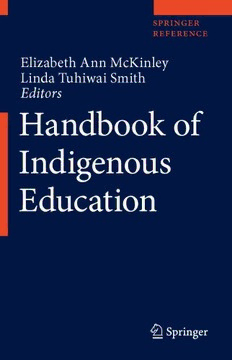
Handbook of Indigenous Education PDF
Preview Handbook of Indigenous Education
Elizabeth Ann McKinley Linda Tuhiwai Smith Editors Handbook of Indigenous Education Handbook of Indigenous Education Elizabeth Ann McKinley Linda Tuhiwai Smith Editors Handbook of Indigenous Education With77Figuresand24Tables Editors ElizabethAnnMcKinley LindaTuhiwaiSmith MelbourneGraduateSchoolofEducation FacultyofMāoriandIndigenousStudies UniversityofMelbourne TheUniversityofWaikato Melbourne,VIC,Australia Hamilton,Waikato,NewZealand ISBN978-981-10-3898-3 ISBN978-981-10-3899-0(eBook) ISBN978-981-10-3900-3(printandelectronicbundle) https://doi.org/10.1007/978-981-10-3899-0 LibraryofCongressControlNumber:2019933556 ©SpringerNatureSingaporePteLtd.2019 Thisworkissubjecttocopyright.AllrightsarereservedbythePublisher,whetherthewholeorpartofthe materialisconcerned,specificallytherightsoftranslation,reprinting,reuseofillustrations,recitation, broadcasting,reproductiononmicrofilmsorinanyotherphysicalway,andtransmissionorinformation storageandretrieval,electronicadaptation,computersoftware,orbysimilarordissimilarmethodology nowknownorhereafterdeveloped. Theuseofgeneraldescriptivenames,registerednames,trademarks,servicemarks,etc.inthispublication doesnotimply,evenintheabsenceofaspecificstatement,thatsuchnamesareexemptfromtherelevant protectivelawsandregulationsandthereforefreeforgeneraluse. Thepublisher,theauthors,andtheeditorsaresafetoassumethattheadviceandinformationinthisbook arebelievedtobetrueandaccurateatthedateofpublication.Neitherthepublishernortheauthorsorthe editorsgiveawarranty,expressorimplied,withrespecttothematerialcontainedhereinorforanyerrors oromissionsthatmayhavebeenmade.Thepublisherremainsneutralwithregardtojurisdictionalclaims inpublishedmapsandinstitutionalaffiliations. ThisSpringerimprintispublishedbytheregisteredcompanySpringerNatureSingaporePteLtd. The registered company address is: 152 Beach Road, #21-01/04 Gateway East, Singapore 189721, Singapore We would like to dedicate this Handbook to the many people who have brought us to this point and made it all possible: first, to those educators, knowledge holders, and leaders of the past who have kept Indigenous knowledge alive, have nurtured and spoken Indigenous languages, struggled for Indigenous rights, and sought to encourage and sustain Indigenous educational aspirations through thedarkestoftimes.Secondly,wededicatethe Handbook to those who work as Indigenous educators in our communities and schools, who hunger for literature that supports and gives evidence to their work. Finally, we dedicate this Handbook to ourearly research leaders who have broken through numerous barriers to clear the way for the work that is presented here. Preface Indigenous communities across the world traditionally had very sophisticated sys- tems of education that were never static but developed as a result of reflection, collective deliberation, and experimentation. These education systems had no end- ing: each generation expanded the community’s knowledge base. Traditionally, learningoccurredasoneparticipated inactivitiesofeverydaylivingandjoiningin life’s ceremonies. While this form of education continues in current times, it is in additiontomorestructuredandformalsettings. The academic field of Indigenous education is a continuation of this journey. Indigenousscholarshavebeenworkingharddevelopingspaceintheacademiesand writingtextswithanaimtoexpandIndigenousknowledgebasesthroughresearch. The text draws attention to the fact that every chapter has been led, and largely entirely produced, by Indigenous academics – a feat that would not have been possibleevenadecadeago. Over the last four or more decades, the education of Indigenous peoples has become an increasingly central preoccupation in many colonized countries across the globe and for international associations. With Indigenous education systems disrupted and often destroyed by colonial invasion and exploitation, the United Nations Declaration on the Rights of Indigenous Peoples (UNDRIP) has brought totheworld’sattentionourrighttoteachourhistories,languages,philosophies,and literature, to establish and control our own education systems and institutions, to teach in a manner appropriate to cultural methods of teaching and learning, to provide education in our own languages, and for all Indigenous children to have access to an education in their own culture and language. This book addresses all theseissuesforIndigenouspeoplesacrosstheglobeandindifferentcontexts. Indigenous education today is a complex, interdisciplinary field of research requiring its Indigenous researchers to straddle disciplines of the academy – a super subject – incorporating subjects such as linguistics, psychology, history, mathematics, astronomy, law, and philosophy, to name but a few, and subjects in the future we have yet tohear about. The Handbook brings together diverse views and strategies from across the world to provide a comprehensive overview of the complexitiesandnuancesofIndigenouspeoples’experiences.Indigenouspeoples’ positioningoneducationislargelydrivenbytheircolonialhistories. vii viii Preface The purpose of the Handbook of Indigenous Education is to provide a state-of- the-art reference and a comprehensive map of the field to date. It is divided into six major sections based ondebatesand topics of interest toIndigenous communi- ties,andeachsectionhas10–12chapters.Eachofthesixsectionsisintroducedby twosectioneditorswhoareinternationallyrecognizedinthefield.Allchaptersare either led or entirely written by Indigenous academics. We attempted to recruit a widespreadofpeoplefromdifferentcountriesandcontinentsacrosstheglobeand achieved this to a large extent; however, we are cognizant there are “gaps.” These gapspresentachallengetoallofusaswemoveforward. The Handbook is available as a print edition and as a fully searchable online version. Melbourne,Australia ElizabethAnnMcKinley Hamilton,NewZealand LindaTuhiwaiSmith March2019 Acknowledgments Therewereanumberofchallengesinputtingtogetherthislargeeditedvolume.We neededtoaccessournetworks,decideonthesectioneditors,andaskthemtochoose authors.Theentireprocessrequirednegotiationskills.Communicationbetweenthe section editors and the editors in chief involved suggestions of authors and topics. Some people approached were not available to write or did not respond to invita- tions.Thisistobeexpected–Indigenousacademicsareoftenovercommitted,trying to satisfy both institutional demands and community obligations. However, books arealways the result of acomplexweb ofrelationships. This bookrepresents, first and foremost, networks within networks of Indigenous scholars and, secondly, another network of allies who have supported the work of Indigenous scholars in theacademy. Wewouldlike tothank those whoacceptedthechallenge andresponsibilityfor being section editors: Leonie Pihama (University of Waikato), Jenny Lee-Morgan (UnitecInstituteofTechnology),GeorgeSefaDei(UniversityofToronto),JeanPaul Restoule(UniversityofVictoria,Canada),MargieHohepa(UniversityofWaikato), Carl Mika (University of Waikato), Graham Hingangaroa Smith (Massey Univer- sity), Melinda Webber (University of Auckland), Bryan McKinley Jones Brayboy (Arizona State University), Megan Bang (North Western University), Sharon Nelson-Barber (WestEd), and Zanette Johnson (Intrinsic Impact Consulting). Your knowledge,networks,andcommitmenttotheprojecthavebeeninstrumentaltothe successofthiswork.WewishtothankthosewhoopenedthisworkuptoIndigenous peoplesnetworksacrosstheglobe. Wewanttoacknowledgetheworkofalloftheauthorswhohavecontributedto thisbook.Wewishtothankyouallforwritingthechaptersandspendingadditional hours on making revisions. It is your contributions that have made this volume possible.Thebookisacelebrationofourcollectiveexpertiseandtherelationships we have with each other. We hope further relationships can be built through thiswork. We would like to express our gratitude to the chapter reviewers for both their expertise and their generosity in giving time to provide the feedback necessary to help make this book a quality contribution to education. The number of people requiredtoreview thistextwasextensive, andweareverypleasedyousharedour vision of the value in this book. We also wish to thank Lilly Brown, who worked ix x Acknowledgments tirelessly as our research assistant. We, as editors in chief, were not always as organized as we could have been, but you managed to keep the threads together. Andlast,butnotleast,wewishtothanktheteamatSpringerwiththeproductionof thebook:SpringereditorNickMelchior,foryoursuggestionthatitwastimelyfor such a volume, and the Springer team we dealt with – Rashmi, Neha, and Mokshika and others too numerous to mention – many thanks for your guidance andassistance. ListofReviewers GlenAikenhead,UniversityofSaskatchewan,Saskatoon,Canada Airini,ThompsonRiversUniversity,Kamloops,Canada LillyBrown,UniversityofMelbourne,Melbourne,Australia GregCajete,UniversityofNewMexico,USA JanepichaCheva-Isarakul,VictoriaUniversityofWellington,Wellington,Aotearoa NewZealand PaulineChinn,UniversityofHawai’i,Honolulu,USA Ho-ChiaChueh,NationalTaiwanUniversity,Taipei,Taiwan GarrickCooper,UniversityofCanterbury,Christchurch,AotearoaNewZealand BronwenCowie,UniversityofWaikato,Hamilton,AotearoaNewZealand RhondaCraven,AustralianCatholicUniversity,Sydney,Australia RuthDeSouza,UniversityofMelbourne,Melbourne,Australia GeorgeSefaDei,UniversityofToronto,Toronto,Canada JulieEvans,UniversityofMelbourne,Melbourne,Australia LesleyFarrell,UniversityofMelbourne,Melbourne,Australia KatieFitzpatrick,UniversityofAuckland,Auckland,AotearoaNewZealand AliciaFlynn,UniversityofMelbourne,Melbourne,Australia CandaceGalla,UniversityofBritishColumbia,Vancouver,Canada LorraineGraham,UniversityofMelbourne,Melbourne,Australia SandyGrande,ConnecticutCollege,NewLondon,Connecticut,USA JohnHattie,UniversityofMelbourne,Melbourne,Australia CamillaHighfield,UniversityofAuckland,Auckland,AotearoaNewZealand MargieHohepa,UniversityofWaikato,Hamilton,AotearoaNewZealand BrendanHokowhitu,UniversityofWaikato,Hamilton,AotearoaNewZealand HuiaJahnke,MasseyUniversity,PalmerstonNorth,AotearoaNewZealand Seu’ulaJohanssonFua,UniversityofSouthPacific(TongaCampus),Suva,Fiji ZanetteJohnson,IntrinsicImpactConsulting,PaloAlto,USA AlisonJones,UniversityofAuckland,Auckland,AotearoaNewZealand TeTakaKeegan,UniversityofWaikato,Hamilton,AotearoaNewZealand TahuKukutai,UniversityofWaikato,Hamilton,AotearoaNewZealand JennyLee-Morgan,UnitecInstituteofTechnology,Auckland,NewZealand MargieMaaka,UniversityofHawai’i(Manoa),Honolulu,USA StephenMay,UniversityofAuckland,Auckland,AotearoaNewZealand CarlMika,TheUniversityofWaikato,Hamilton,AotearoaNewZealand AngusMcfarlane,UniversityofCanterbury,Christchurch,AotearoaNewZealand Acknowledgments xi SonjaMcfarlane,UniversityofCanterbury,Christchurch,AotearoaNewZealand TracyMcIntosh,UniversityofAuckland,Auckland,AotearoaNewZealand Elizabeth Ann McKinley, Melbourne Graduate School of Education, University of Melbourne,Melbourne,Australia JulieMcLeod,UniversityofMelbourne,Melbourne,Australia SueMentha,UniversityofMelbourne,Melbourne,Australia SueMiddleton,UniversityofWaikato,Hamilton,AotearoaNewZealand NikkiMoodie,UniversityofMelbourne,Melbourne,Australia BernadetteMurphy,UniversityofMelbourne,Melbourne,Australia SharonNelson-Barber,WestEd,SanFrancisco,USA SophieNock,UniversityofWaikato,Hamilton,AotearoaNewZealand RachelNordlinger,UniversityofMelbourne,Melbourne,Australia Adreanne Ormond, Victoria University of Wellington, Wellington, Aotearoa NewZealand LeoniePihama,UniversityofWaikato,Hamilton,AotearoaNewZealand JelenaPorsanger,SamiUniversityofAppliedSciences,Kautokeino,Norway DonnRatana,UniversityofWaikato,Hamilton,AotearoaNewZealand Jean-PaulRestoule,UniversityofVictoria,BritishColumbia,Canada Lester-IrabinnaRigney,UniversityofSouthAustralia,Adelaide,Australia FazalRizvi,UniversityofMelbourne,Melbourne,Australia RaukuraRoa,UniversityofWaikato,Hamilton,AotearoaNewZealand ChristineRubie-Davies,UniversityofAuckland,Auckland,AotearoaNewZealand SophieRudolph,UniversityofMelbourne,Melbourne,Australia KabiniSanga,VictoriaUniversityofWellington,Wellington,AotearoaNewZealand GlennSavage,UniversityofWesternAustralia,Perth,Australia Wee-TiongSeah,UniversityofMelbourne,Melbourne,Australia RaeSi’ilata,UniversityofAuckland,Auckland,AotearoaNewZealand NaomiSimmons,UniversityofWaikato,Hamilton,AotearoaNewZealand MereSkerrett,VictoriaUniversityofWellington,AotearoaNewZealand ChristineSleeter,CaliforniaStateUniversityMontereyBay,California,USA RobinSmall,UniversityofMelbourne,Melbourne,Australia Cherryl Waerea-i-te-rangi Smith, Te Atawhai o te Ao, Whanganui, Aotearoa NewZealand GrahamHingangaroaSmith,MasseyUniversity,PalmerstonNorth,NewZealand JillSmith,UniversityofAuckland,Auckland,AotearoaNewZealand KylieSmith,UniversityofMelbourne,Melbourne,Australia LindaTuhiwaiSmith,TheUniversityofWaikato,Hamilton,Waikato,NewZealand R.D.KekehaSolis,UniversityofHawai’i(Manoa),Honolulu,USA DawnSutherland,UniversityofWinnipeg,Winnipeg,Canada TonyTrinick,UniversityofAuckland,Auckland,AotearoaNewZealand MaliaVillegas,AfognakNativeCorporation(KodiakIsland),Alaska,USA MaggieWalter,UniversityofTasmania,Hobart,Australia TeRinaWarren,MasseyUniversity,PalmerstonNorth,AotearoaNewZealand MelindaWebber,UniversityofAuckland,Auckland,AotearoaNewZealand
